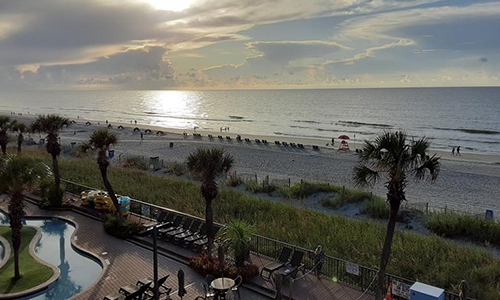
The best souvenirs you can take home from your Myrtle Beach vacation are absolutely free and incredibly plentiful; you just have to find them.
That’s not a problem on the Grand Strand, a 60-mile stretch of pristine Carolina coastline that is fertile hunting grounds for rare seashells.
Shelling, as it is called by dedicated fossil-fetchers, is not only a fun, affordable, family-friendly activity; it’s also rewarding for those with patience and a keen eye. There are an array of beautiful seashells, sharks’ teeth and other finds that make great Myrtle Beach mementos.
Sure, guests at Compass Cove Oceanfront Resort can walk into one of the local beachwear stores or souvenir shops to purchase polished seashells. But the enjoyment of strolling along the shoreline and finding your own buried treasure is priceless (literally and figuratively).
There are a few steps you want to take before packing them up for the trip home. Here’s a quick how-to guide for shelling in Myrtle Beach:
Easy as A-B-C-Shells
Shelling is like a treasure hunt that everyone can do as long as you know the basics. The best hunting is usually below the high tide line – not the fluffy white sand that is closest to the dunes but the wet sand that absorbs the ocean waves. A falling tide is ideal as the retreating surf repeatedly reveals new finds. Use your toes to unearth partially buried shells or invest in a filtered scoop on a stick. Low tide and a post-storm tide cycle are the best times to find some big ones. Be sure to take a zip-lock bag or beach bucket to carry your keepers.
Identifying Shells
The only thing you really need to know about selecting a shell is whether or not you like it. But for those seeking specific types of shells, here are some of the most sought-after on the Grand Strand – the Lettered Olives (South Carolina state shell), Atlantic Moon Shells, Calico Scallops, Banded Tulips and Coquina Clams. Perhaps most popular are sharks’ teeth (look for black fossils with sharp angles) and even ancient Megalodon teeth. Searchers can also find the occasional sand dollar and starfish but often in pieces.
Cleaning and Polishing Shells
Most of the shells you find can be easily cleaned for the trip home. Simply rinse them off and rub away any sand or silt. But others, particularly the enclosed shells, may still have living organisms inside. Experienced shellers will simply leave those behind out of respect for even the tiniest sea creatures. But if you must, be sure to boil the shells and remove the remaining tissue with tweezers. For those looking to preserve and display their finds, soak them in a mix of water and bleach for a week, lay them out to dry and apply mineral oil for a shiny sheen and protective coat.
Turning Nature into Art
Don’t waste your time collecting a lot of seashells and leaving them in storage. Get creative and turn those souvenirs into a real conversation piece. Easy projects include storing your colorful shells in a clear glass jar or a bowl filled with sand. Another crafty project involves attaching shells to the edges of a glass mirror or a picture frame. Certain shells can be used to make candles and lights, or simply use them as a ash tray or soap dish. These small treasures will serve as a happy reminder of your beach trip.
Now that you know the basics of shelling, it’s time to hit the beach and rack up on the free souvenirs. Book your next Myrtle Beach vacation at Compass Cove Resort and prepare to dig deep to find some keepers.
